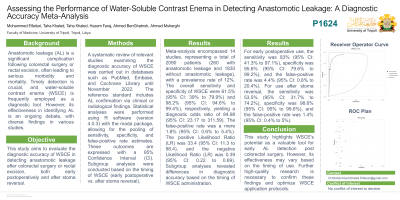Monday Poster Session
Category: Colon
P1624 - Assessing the Performance of Water-Soluble Contrast Enema in Detecting Anastomotic Leakage: A Diagnostic Accuracy Meta-Analysis
Monday, October 23, 2023
10:30 AM - 4:15 PM PT
Location: Exhibit Hall

Has Audio
- ME
Muhammed Elfaituri, MBBCh
University of Tripoli
Tripoli, Tripoli, Libya
Presenting Author(s)
Muhammed Elfaituri, MBBCh, Taha Khaled, , Ahmed BenGhatnsh, MBBCh, Hazem Faraj, MBBCh, Ahmed Msherghi, MBBCh
University of Tripoli, Tripoli, Tripoli, Libya
Introduction: Anastomotic leakage (AL) is a significant complication following colorectal surgery or rectal excision. Timely detection is crucial, and water-soluble contrast enema (WSCE) is frequently employed as a diagnostic tool. However, its effectiveness in identifying AL is an ongoing debate. This study aims to evaluate the diagnostic accuracy of WSCE in detecting anastomotic leakage after colorectal surgery or rectal excision, both early postoperatively and after stoma reversal.
Methods: A systematic review of relevant studies examining the diagnostic accuracy of WSCE was carried out in databases such as PubMed, Embase, and Cochrane Library until November 2022. The reference standard includes AL confirmation via clinical or radiological findings. Statistical analyses were performed using R software (version 4.0.3) with the mada package, allowing for the pooling of sensitivity, specificity, and false-positive rate estimates. These outcomes are expressed with a 95% Confidence Interval (CI). Subgroup analyses were conducted based on the timing of WSCE (early postoperative vs. after stoma reversal).
Results: Our meta-analysis encompassed 14 studies, representing a total of 2090 patients (260 with anastomotic leakage and 1830 without anastomotic leakage), with a prevalence rate of 12%. The overall sensitivity and specificity of WSCE were 61.5% (95% CI: 39% to 79.9%) and 98.2% (95% CI: 94.6% to 99.4%), respectively, yielding a diagnostic odds ratio of 84.98 (95% CI: 23.17 to 311.59). The false-positive rate was a mere 1.8% (95% CI: 0.6% to 5.4%). The positive Likelihood Ratio (LR) was 33.4 (95% CI: 11.3 to 98.4), and the negative Likelihood Ratio (LR) was 0.39 (95% CI: 0.22 to 0.69). Subgroup analyses revealed differences in diagnostic accuracy based on the timing of WSCE administration. For early postoperative use, the sensitivity was 83% (95% CI: 41.3% to 97.1%), specificity was 95.6% (95% CI: 79.6% to 99.2%), and the false-positive rate was 4.4% (95% CI: 0.8% to 20.4%). For use after stoma reversal, the sensitivity was 53.5% (95% CI: 31.7% to 74.2%), specificity was 98.6% (95% CI: 95% to 99.6%), and the false-positive rate was 1.4% (95% CI: 0.4% to 5%).
Discussion: This study highlights WSCE's potential as a valuable tool for early AL detection post colorectal surgery. However, its effectiveness may vary based on the timing of use. Further high-quality research is necessary to confirm these findings and optimize WSCE application protocols.
Disclosures:
Muhammed Elfaituri, MBBCh, Taha Khaled, , Ahmed BenGhatnsh, MBBCh, Hazem Faraj, MBBCh, Ahmed Msherghi, MBBCh. P1624 - Assessing the Performance of Water-Soluble Contrast Enema in Detecting Anastomotic Leakage: A Diagnostic Accuracy Meta-Analysis, ACG 2023 Annual Scientific Meeting Abstracts. Vancouver, BC, Canada: American College of Gastroenterology.
University of Tripoli, Tripoli, Tripoli, Libya
Introduction: Anastomotic leakage (AL) is a significant complication following colorectal surgery or rectal excision. Timely detection is crucial, and water-soluble contrast enema (WSCE) is frequently employed as a diagnostic tool. However, its effectiveness in identifying AL is an ongoing debate. This study aims to evaluate the diagnostic accuracy of WSCE in detecting anastomotic leakage after colorectal surgery or rectal excision, both early postoperatively and after stoma reversal.
Methods: A systematic review of relevant studies examining the diagnostic accuracy of WSCE was carried out in databases such as PubMed, Embase, and Cochrane Library until November 2022. The reference standard includes AL confirmation via clinical or radiological findings. Statistical analyses were performed using R software (version 4.0.3) with the mada package, allowing for the pooling of sensitivity, specificity, and false-positive rate estimates. These outcomes are expressed with a 95% Confidence Interval (CI). Subgroup analyses were conducted based on the timing of WSCE (early postoperative vs. after stoma reversal).
Results: Our meta-analysis encompassed 14 studies, representing a total of 2090 patients (260 with anastomotic leakage and 1830 without anastomotic leakage), with a prevalence rate of 12%. The overall sensitivity and specificity of WSCE were 61.5% (95% CI: 39% to 79.9%) and 98.2% (95% CI: 94.6% to 99.4%), respectively, yielding a diagnostic odds ratio of 84.98 (95% CI: 23.17 to 311.59). The false-positive rate was a mere 1.8% (95% CI: 0.6% to 5.4%). The positive Likelihood Ratio (LR) was 33.4 (95% CI: 11.3 to 98.4), and the negative Likelihood Ratio (LR) was 0.39 (95% CI: 0.22 to 0.69). Subgroup analyses revealed differences in diagnostic accuracy based on the timing of WSCE administration. For early postoperative use, the sensitivity was 83% (95% CI: 41.3% to 97.1%), specificity was 95.6% (95% CI: 79.6% to 99.2%), and the false-positive rate was 4.4% (95% CI: 0.8% to 20.4%). For use after stoma reversal, the sensitivity was 53.5% (95% CI: 31.7% to 74.2%), specificity was 98.6% (95% CI: 95% to 99.6%), and the false-positive rate was 1.4% (95% CI: 0.4% to 5%).
Discussion: This study highlights WSCE's potential as a valuable tool for early AL detection post colorectal surgery. However, its effectiveness may vary based on the timing of use. Further high-quality research is necessary to confirm these findings and optimize WSCE application protocols.
Disclosures:
Muhammed Elfaituri indicated no relevant financial relationships.
Taha Khaled indicated no relevant financial relationships.
Ahmed BenGhatnsh indicated no relevant financial relationships.
Hazem Faraj indicated no relevant financial relationships.
Ahmed Msherghi indicated no relevant financial relationships.
Muhammed Elfaituri, MBBCh, Taha Khaled, , Ahmed BenGhatnsh, MBBCh, Hazem Faraj, MBBCh, Ahmed Msherghi, MBBCh. P1624 - Assessing the Performance of Water-Soluble Contrast Enema in Detecting Anastomotic Leakage: A Diagnostic Accuracy Meta-Analysis, ACG 2023 Annual Scientific Meeting Abstracts. Vancouver, BC, Canada: American College of Gastroenterology.
